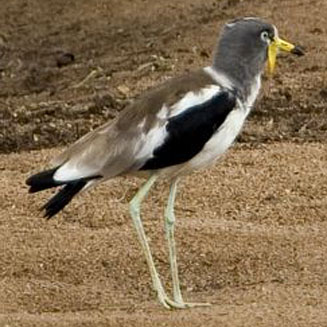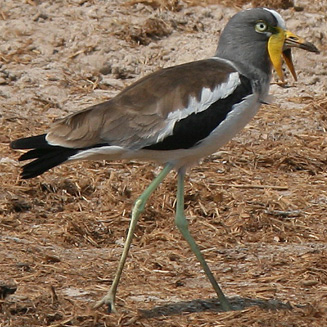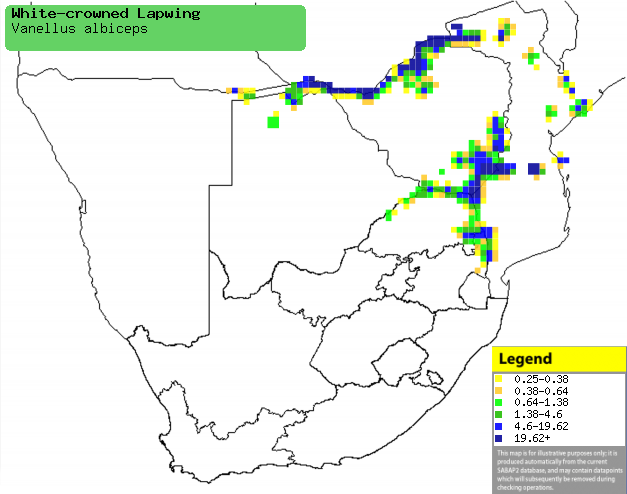|
Vanellus albiceps (White-crowned
lapwing, White-crowned plover)
Witkopkiewiet [Afrikaans]; Witkruinkievit [Dutch]; Vanneau
à tête blanche [French]; Langspornkiebitz [German]; Abibe-de-coroa-branca
[Portuguese]
Life
> Eukaryotes >
Opisthokonta
> Metazoa (animals) >
Bilateria >
Deuterostomia > Chordata >
Craniata > Vertebrata (vertebrates) > Gnathostomata (jawed
vertebrates) > Teleostomi (teleost fish) > Osteichthyes (bony fish) > Class:
Sarcopterygii (lobe-finned
fish) > Stegocephalia (terrestrial
vertebrates) > Tetrapoda
(four-legged vertebrates) > Reptiliomorpha > Amniota >
Reptilia (reptiles) >
Romeriida > Diapsida > Archosauromorpha > Archosauria >
Dinosauria
(dinosaurs) > Saurischia > Theropoda (bipedal predatory dinosaurs) >
Coelurosauria > Maniraptora > Aves
(birds) > Order: Charadriiformes
> Family: Charadriidae > Genus: Vanellus
 |
 |
|
White-crowned lapwing, Kruger National Park, South
Africa. [photo Trevor Hardaker ©] |
White-crowned lapwing, Botswana. [photo
Mike Grimes
©] |
Distribution and habitat
Endemic to the Afrotropics, from Senegal to the Central
African Republic south to northern Angola, with a separate population in
Tanzania, Zambia and southern Africa. Within southern Africa it is uncommon in north-western and
south-western Zimbabwe, north-eastern South Africa, central and northern
Mozambique, northern Botswana and the Caprivi Strip (Namibia). It generally
prefers sand and mudbanks along large rivers, lakes and dams; during
floods it often moves to streams, lagoons and pans.
|
 |
|
Distribution of White-crowned lapwing in southern Africa,
based on statistical smoothing of the records from first SA Bird Atlas
Project (©
Animal Demography unit, University of
Cape Town; smoothing by Birgit Erni and Francesca Little). Colours range
from dark blue (most common) through to yellow (least common).
See here for the latest distribution
from the SABAP2. |
Movements and migrations
Mostly sedentary in southern Africa, although
it moves away from rivers when they flood or dry up, while juveniles
disperse widely after becoming independent.
Food
It mainly eats insects and aquatic invertebrates, doing
most of its foraging close to the water, locating prey visually before plucking
them from the surface. The following food items have been recorded
in its diet:
- Invertebrates
- insects
- crustaceans (such as crabs)
- molluscs
- worms
- Vertebrates
Breeding
- Monogamous, defending a linear territory along the river bed.
- The nest is a shallow scrape in a damp sandbank, occasionally lined with
small sticks and pebbles. It is typically placed in the open, occasionally
adjacent to a driftwood or vegetation.
- Egg-laying season is from July-November, peaking from August-October.
- It lays 2-4 eggs, which are incubated by both sexes for at least 26
days, although they are often left unattended (sometimes in the hottest part of the
day).
- The chicks can feed themselves within 24 hours of hatching and are cared
for by both parents, who become increasingly aggressive towards intruders.
Threats
Near-threatened in South Africa, largely due to
decreased river flow, which is probably caused by afforestation, invasive plants
and obstruction by man-made structures (such as dams).
References
-
Hockey PAR, Dean WRJ and Ryan PG 2005. Roberts
- Birds of southern Africa, VIIth ed. The Trustees of the John Voelcker
Bird Book Fund, Cape Town.
|
